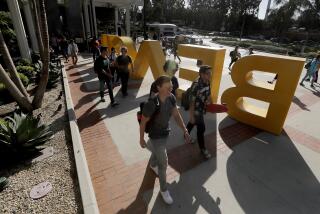Marin County’s Wealth Doesn’t Extend to Community Colleges
- Share via
Marin County, home to some of the state’s wealthiest residents, also has the most financially troubled community college district in the state.
“It’s ironic,” said Greg Brockbank, president of the college Board of Trustees, “Marin County is so wealthy . . . but it’s like we’re some little, poor, rural district.”
The College of Marin has the worst rating of any institution on the California Community College chancellor’s watch list of fiscally troubled districts, a distinction earned when its reserves fell below 3% of its budget.
The district’s long downward spiral is largely the result of enrollment declines and a corresponding shrinkage of state funds.
District leaders have cut support services and plundered equipment budgets and reserves to keep the district afloat.
Over the years, there have been myriad schemes to lure students and brake the district’s financial slide--proposals for affordable housing on the campuses and business incubators.
But the situation remains so frustrating that even the most optimistic college officials acknowledge that improvement will come slowly at best, and the district may face many lean years to come.
The district has been working against a demographic losing hand. Enrollment at the college has declined about 15% since the early 1980s to about 14,300, said Scott Miller, vice president of business services.
Marin County’s personal income per capita is the highest of any in the state, and the median home price as of last November was $331,000. As Marin County has grown richer, it has also grown grayer, and its pool of community college students has gotten smaller.
The enrollment decline has been exacerbated by the cost of maintaining the district’s newer second campus, Miller said.
Built in the late 1970s on the faith that the city of Novato’s population would rapidly expand, Marin’s Indian Valley campus has never drawn the expected number of students.
District leaders have considered shutting down the campus. But whenever the idea is mentioned, said Marie McCarthy, president of the college’s academic senate, “the citizenry of Novato come en masse and say, ‘No, no, no.’ ”
Staff costs, meanwhile, have increased.
Marin’s faculty union has won what is considered a favorable contract, with exceptionally high compensation for part-time faculty.
Union members must grapple with the region’s high cost of living, justifying higher pay, district officials say. But Miller said the district needs to do a better job of “tying our faculty raises to the kind of income we have.”
In other words, the board needs to be certain not to spend more than it takes in--a seemingly simple accounting principle that is not always held sacrosanct in the world of community colleges.
Last year, Marin’s board approved staff raises totaling $360,000. There wasn’t enough money for that, however, forcing a $60,000 draw on reserves.
The giant Los Angeles district has been criticized for similar missteps; it was scolded by auditors last year for approving faculty raises without first making sure the district could pay for them.
College officials could tap the wealth of constituents by levying a local parcel tax, as has been levied by primary and secondary schools there. That, however, would require two-thirds approval of the electorate. Even supporters of the idea doubt it would pass.
While acknowledging the problems, Marin Supt. and President Jim Middleton said the underlying problem is a chronic under-funding of community colleges. The colleges receive a lower per-student share of state funds than primary and secondary schools, and public universities.
For now, Middleton said, the college is investing in general education, forging new partnerships and seeking private donations. State officials say that its status on the watch list may soon be upgraded.
Also helping is a small projected increase in the number of high school graduates and faculty retirements, which will help reduce costs, Middleton said.
More to Read
Sign up for Essential California
The most important California stories and recommendations in your inbox every morning.
You may occasionally receive promotional content from the Los Angeles Times.










